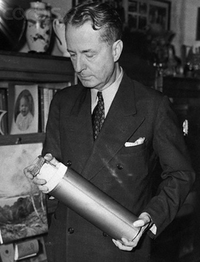Thornwell Jacobs
Thornwell Jacobs | |
|---|---|
 Dr. Thornwell Jacobs, president of Oglethorpe University, shown sealing the last cylinder to be placed in the Crypt of Civilization. | |
| Born | 15 February 1877 |
| Died | 4 August 1956 |
| Occupation(s) | Presbyterian minister, author, educator, business executive |
| Known for | educator, "time capsule" |
| Parent(s) | William Plumer Jacobs Mary Jane (Dillard) |
Thornwell Jacobs (1877–1956) was an educator, author, and a Presbyterian minister.[1]
Early life
Jacobs was born in Clinton, South Carolina, February 15, 1877, at the Thornwell Orphanage.[2][3] The orphanage was founded by his father, Reverend William Plumer Jacobs.[3] His mother was Mary Jane (Dillard) Jacobs.[2]
Jacobs learned the printing trade while he was still quite young. Later he earned the Bachelor of Arts degree and Master of Arts degree from South Carolina's Presbyterian College in 1895, also founded by his father.[2][3] He also graduated from Princeton Theological Seminary in New Jersey in 1899.[2][3]
His grandfather Ferdinand Jacobs taught Mathematics and Astronomy at the antebellum Oglethorpe University, based in Milledgeville, GA, from 1845 to 1849.
Adult life
Jacobs served as a Presbyterian pastorate in Morganton at the Presbyterian Church from 1900 to 1903. He then worked in advertising in Nashville, Tennessee, until 1905. After this time Jacobs began institutional support for the Thornwell Orphanage.[3]
Career
Jacobs is noted for revitalizing and rebuilding the antebellum college of Oglethorpe University. He became its president on January 21, 1915 and continued in that position for nearly three decades.[1] Oglethorpe University, named after James Edward Oglethorpe, the founder of the colony of Georgia, had been chartered a Presbyterian institution in 1835.[4] It had been shut down during the American Civil War and did not successfully reopen until Jacobs intervened.[3]
Other
In 1922 Jacobs rediscovered the burial place of General James Edward Oglethorpe in Cranham, England.[1]
Crypt of Civilization
Jacobs originated the Crypt of Civilization time capsule at Oglethorpe University. It was sealed off with steel doors in 1940.[1][3] According to the Guinness Book of World Records it is "the first successful attempt to bury a record of this culture for any future inhabitants or visitors to the planet Earth." [5]
Jacobs initially planned and designed the Crypt of Civilization storage space to preserve information of the early 20th century in 1935.[6] He discussed this proposal in an article in Scientific American, November 1936, because he was struck by the dearth of information on the ancient civilizations.[7] Jacobs wrote of a unique plan to present a "running story" of life and customs. He wanted to show the accumulated knowledge of mankind up until his time.[7]
The Crypt was sealed on May 28, 1940. It is intended to be opened May 28, 8113 C.E.. Jacobs is known as the "father of the modern time capsule."[8][9] George Edward Pendray is the person responsible for coining the term time capsule.[6][10][11] Pendray is also the one responsible for the Westinghouse time capsule that was buried in 1938 for the 1939 New York World's Fair.[7] Pendray "borrowed" the original idea from Jacobs.[12][13][14] Originally Westinghouse's project was named "time bomb".[6]
The date of 8113 C.E. was calculated by Jacobs from the first fixed date in history, 4241 B.C.E. This is the time that most historians believe was when the Egyptian calendar was established. The Crypt's projected intended opening is in exactly 6177 years.[1] This is the number of years between 4241 BCE and 1936 CE. Jacobs projected the same period of time forward from 1936 giving this opening date of 8113.[8]
Death
Jacobs died August 4, 1956. He is buried at the First Presbyterian Church cemetery in Clinton, South Carolina.[2][3]
Works
- Sinful Saddy (1907)
- The Law of the White Circle (1908), a novella.
- Midnight Mummer (poems) (1911)
- The Oglethorpe Story (1916)
- Life of William Plumer Jacobs (1918)
- New Science and the Old Religion (1927)
- Islands of the Blest (poems) (1928)
- Oglethorpe Book of Georgia Verse (1930)
- Diary of William Plumber Jacobs (1937)
- William Plumber Jacobs Memorabilla (1942)
- Red Lanterns on St. Michael's (1940), an historical novel about the Siege of Charleston during the American Civil War.
- Story of Christmas (1941)
- Drums of Doomsday (1942), a novel about a visionary Presbyterian minister who attempts to bring religion to Hollywood.
- Step down, Dr. Jacobs (1945)
- When For The Truth - A Novel of Reconstruction Days in South Carolina (1950)
References
- ^ a b c d e "Article on Paul Stephen Hudson". Retrieved 2008-06-28.
- ^ a b c d e Who Was Who, p. 443
- ^ a b c d e f g h "The New Georgia Encyclopedia". Retrieved 2008-07-05.
- ^ "The New Georgia Encyclopedia — Education — Oglethorpe University". Retrieved 2008-06-28.
- ^ Guinness Book of World Records 1990.
- ^ a b c Jarvis, p. 155. McFarland. 2003. ISBN 978-0-7864-1261-7. Retrieved 2008-06-28.
- ^ a b c "History of the Crypt of Civilization". Retrieved 2008-06-28.
- ^ a b "Oglethorpe University - International Time Capsule Society". Retrieved 2008-07-05.
- ^ Jarvis, page 232. McFarland. 2003. ISBN 978-0-7864-1261-7. Retrieved 2008-07-05.
- ^ "Princeton University Library — G. Edward Pendray Papers, 1829–1981 (bulk 1923–1971)". Retrieved 2008-06-28.
- ^ New York Times, August 19, 1938, page 21
- ^ Jarvis, p. 153. McFarland. 2003. ISBN 978-0-7864-1261-7. Retrieved 2008-06-28.
- ^ Jarvis, p. 155. McFarland. 2003. ISBN 978-0-7864-1261-7. Retrieved 2008-06-28.
- ^ Jarvis, p. 156. McFarland. 2003. ISBN 978-0-7864-1261-7. Retrieved 2008-06-28.
Bibliography
- Who Was Who in America, Volume 3, 1951–1960. Chicago: Marquis Who's Who, 1966
- Jarvis, William E., Time Capsules: A Cultural History, McFarland 2002, ISBN 0-7864-1261-5
External links
- New Georgia Encyclopedia entry for Thornwell Jacobs
- Thornwell Jacobs (1877-1956) Find A Grave Memorial
- Thornwell Jacobs Legacy Celebration 2012-Oglethorpe University YouTube video.
